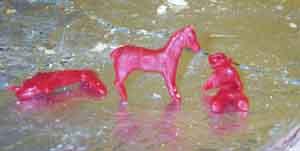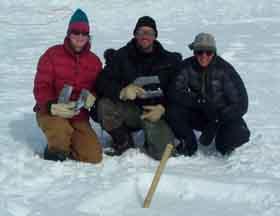8 May, 2003
Weather: -33, wind less than 5 knots, ice fog reducing visibility
Camp Life:
Kangstered – When you are done collecting data, everything is packed and you are ready to go but the weather in Kangerlussauq is so bad that the plane cannot fly. You are just stuck!
Yesterday we finished drilling and took down the camp preparing to leave. I even went as far as stuffing my sleeping bag and rolling my therma-rest before looking outside this morning. As I headed to the cook tent where communication with Kanger takes place I realized we would be staying at least another night. What to do? What to do?
Bowling, reading and conversation… Using a snow saw, I cut some bowling pins that we could slide a mallet to knock them over for a little recreation. We talked about setting up bocce ball with water bottles, horse shoes with bamboo stakes, etc… If we are still here tomorrow we may set up polar Olympics! Later, many people retreated to their books for an afternoon of relaxation. At all times there was always someone in the 12 by 12 cook tent, producing some creative conversation and ideas to the world’s problems. The students inMelter. Cut ice images
Hard core science
Once the ice leaves Greenland it is sent to Nickel Laboratory in Denver, Colorado. At this lab they cut the ice cores into long rectangles. Cutting the outside of the core helps reduce the amount of contamination from core handlers.
Melting the cut ice cores is the first step of hard core science in the laboratory. The cut sections of ice are placed into a melter. For this project, as the ice is melted the water then travels to an ICP-MS (Inductively Coupled Plasma – Mass Spectrometer). Simply said, as the water travels into this machine, it is able to tell different elements in very small levels. The levels can be so small that they are measured in parts per billion or parts per trillion. Trying to imagine one in a million is hard, think how small one per trillion is.
Greenland’s ice cap is a perfect place to sample as it acts like a big sink that captures air parcticles. The parcticles that are in the air get snowed out and deposited on the ice sheet. Because the ice sheet is always frozen, the snow just piles up on itself storm after storm. Hence, if you dig down deep enough, you can see what was snowed out last year, or 10 years ago, or 100 years ago or even more. By looking at the chemistry of the different layers, you can tell things about the climate and pollution over history.
Some elements such as vanadium and lead isotopes can be used to look at climate processes or determine the amount of pollution that is was created in industrial areas and dumped in Greenland’s ice cap. What is even more interesting is that by looking at some parcticular elements, you can tell an approximate region that it came from. For example, lead from one region is often times different than lead from another region. Because of this, scientists can predict if the lead was from Eastern Canada, Asia, Western United States, etc…
Ryan Banta

This melter was partially designed by Dr. Greg Malorey. There are 4 cameras attached to help measure the rate of melting. The ice that is cut in a rectangle fits into the melter and is slowly melted so only the middle of the ice is used to minimize contamination. From here the melted ice goes to the ICP MS.

The ice that is cut in Denver, CO is the length of the original tube, about 1m but is cut from a 10cm radius to a 2inch by 2inch square that will fit into the melter.

Too much time in the tent. These creatures were made from coating on gouda cheese

A horseshoe match as we wait hte day out.
Contact the TEA in the field at
.
If you cannot connect through your browser, copy the
TEA's e-mail address in the "To:" line of
your favorite e-mail package.
|
